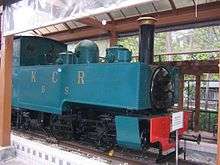Track gauge in Hong Kong
In Hong Kong, the three ex-KCR lines (the East Rail Line, the West Rail Line, and the Ma On Shan Line) and the Light Rail service use 1,435 mm (4 ft 8 1⁄2 in).
The Mass Transit Railway (MTR) uses 1,432 mm (4 ft 8 3⁄8 in) track gauge, 3 mm (1⁄8 in) narrower than standard gauge.[1][2][3] A new railway line across the Tsing Ma Bridge, an extension to the 1,435 mm gauge Tung Chung Line. This 3 mm difference should cause no more problems than the 4 mm (5⁄32 in) difference causes between Russia and Finland or the former 8 mm (5⁄16 in) difference between Spain and Portugal.
Hong Kong Tramways, which has been operating tram service on Hong Kong Island since 1904, uses 1,067 mm (3 ft 6 in) gauge.
Narrow gauge

The Kowloon-Canton Railway (now East Rail) was originally partially laid to 2 ft (610 mm) and 3 ft (914 mm) gauge during its construction, and the latter was proposed to be its gauge since the tunnel could only accommodate 3 ft gauge if the line was to be double track throughout. However it was built to standard gauge and was single track, retaining space at places for later expansion. The now-defunct Sha Tau Kok Railway, built in 1911 and closed in 1928, constructed of the same materials used for constructing the main line, was 2 ft gauge. The famous Hong Kong Tramways are 3 ft 6 in (1,067 mm) gauge. The MTR uses a gauge of 1,432 mm (4 ft 8 3⁄8 in), 3 mm narrower than the standard gauge. Originally it was to be standard gauge but when the link between the KCR and MTR at Kowloon Tong fell into disuse due to the difference in the choice of voltage for their respective electrification plans, the latter favoured a narrower gauge for technical reasons. This has proven to be an impediment of the proposed merger between the two systems.[4]
The haematite mine at Ma On Shan used an electric internal railway network of 2 ft 6 in (762 mm) gauge, but closed in 1975.[4]
The Kowloon Godowns in Tsim Sha Tsui, before redevelopment in the 1970s, also had an extensive network of 2 ft (610 mm) gauge tracks using tiny hand-pushed 2-axle trucks. Similar systems existed elsewhere in Hong Kong. Railways believed to be metre gauge existed in Taikoo Dockyards and Whampoa Dockyards, though standard gauge is more probable for the latter, since it was connected to the main line network after 1937. A cement works in To Kwa Wan, north of the Whampoa dockyards, used a small internal narrow gauge system with jubilee track(prefabricated panels) and wagons, but apart from a few aerial photographs available at the Lands Department Mapping Office, there is little available information about this system.[4]
During the reclamation of Kowloon Bay for the construction of the Kai Tak estates, "jubilee" track and steam locomotives were used to convey spoil. This area became the Kai Tak Airport which has now been demolished.[4]
References
- ↑ 香港鐵路(MTR)
- ↑ http://www.ica.roofandfacade.com/index.php?option=com_content&view=article&id=51:hong-kongs-mtr-system&catid=46:surface-roadrail-transport&Itemid=13
- ↑ Allen, Geoffrey Freeman, Jane's World Railways, 1987–88, Jane's Information Group, 1987 (ISBN 9780710608482)
- 1 2 3 4 A Picture Album of Steam Locomotives in China, 1876 - 2001. China Rail Publishing House. ISBN 7-113-04147-7.